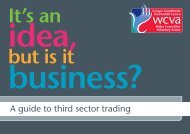Measuring Impact - Nicva
Measuring Impact - Nicva
Measuring Impact - Nicva
You also want an ePaper? Increase the reach of your titles
YUMPU automatically turns print PDFs into web optimized ePapers that Google loves.
The development of indicators for impact assessment 47<br />
7.2.3 Interviews and focus groups<br />
Background information was collected at this stage. This included data on AFG’s organisational<br />
structure, number of employees, funding, and geographical remit; together with<br />
project-specific data such as courses available and numbers of people attending courses.<br />
These input and output measures provided the contextual information for the impact study.<br />
When carrying out a study of this nature, it is vital that the organisation and staff work closely<br />
with the researcher. In this case-study it was NICVA who approached AFG to take part in the<br />
research. It was important to explain the whole process, from identifying appropriate stakeholders<br />
to the benefits that could be gained for their organisation. In the case of an organisation<br />
carrying out its own impact analysis the full participation of the staff will be equally important.<br />
Focus groups and unstructured interviews were arranged with staff and groups affiliated to<br />
AFG. They explored with participants their perceptions of the organisation’s overall impact,<br />
focusing on the concepts of human and social capital.<br />
7.2.4 Selecting an existing analytical framework<br />
A significant aspect of the voluntary sector’s impact is its contribution to social capital,<br />
including trust and civic participation, and to human capital, such as confidence and new<br />
skills. In order to capture these different types of impact, an analytical framework was<br />
selected which focused on both social and human capital, namely the framework developed<br />
by the New Economics Foundation (NEF). Another similar framework considered but not<br />
used was that developed by Community Evaluation Northern Ireland (a community-based<br />
evaluation organisation) which was based upon categories devised by the World Bank, and<br />
tailored to the Northern Irish context.<br />
One of the advantages of the NEF framework is that it also captured relationships within and<br />
between organisations. As the project developed, the framework headings were tailored to<br />
meet the needs of individual and group interviews, and extended to include a wider range of<br />
possible impacts.<br />
Indicators were developed from themes that recurred in the interviews. These were then<br />
grouped under the framework headings and under any additional themes identified.<br />
Indicators were developed for each of the sets of stakeholders identified in the system. Care<br />
was taken to ensure that they were clearly worded and relevant to the organisation and that<br />
they covered the full range of the organisation’s activities.












